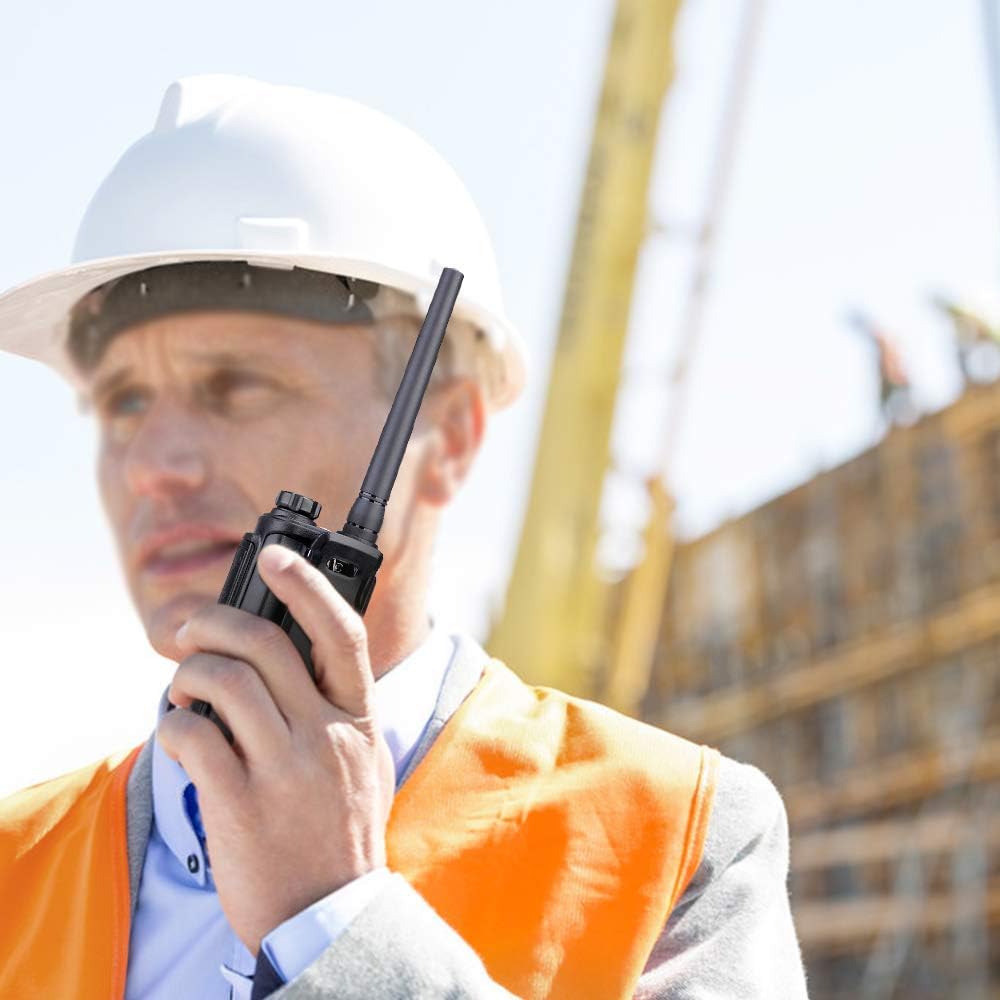You just bought a radio device or are planning to buy one and are wondering if I could use it legally without purchasing any license. If that is the case, no need to fret, you have come to the right place. I will guide you through all of the things you need to know about using radio devices such as Personal Radio Service – Ham radios and Walkie-talkies without a license. For those who are new to the radio world, we welcome you and there is no need to worry if you are not familiar with what frequencies actually are.
After reading through, you will have a better knowledge of Frequencies. So let’s get started. But hang on, before we get started we should be aware That all of the details about the use of radio services without a license are according to the Federal Communications Commission (FCC).
Radio waves and frequencies
 We start with the question, What are radio frequencies? And to answer that we need to know about radio waves. Radio waves are the building block of radio communication. All waves carry some kind of energy and in the case of radio communication, the energy carried by radio waves can be referred to as data and information. The frequency of a wave is the number of waves passing through a fixed point in a given time. So if 5 radio waves pass through a point in 1s then it can be said that the radio frequency is 5 Hz.
We start with the question, What are radio frequencies? And to answer that we need to know about radio waves. Radio waves are the building block of radio communication. All waves carry some kind of energy and in the case of radio communication, the energy carried by radio waves can be referred to as data and information. The frequency of a wave is the number of waves passing through a fixed point in a given time. So if 5 radio waves pass through a point in 1s then it can be said that the radio frequency is 5 Hz.
Transmitting and receiving radio waves
Sounds captured by a microphone are represented as electrical signals. Radio transmitters convert these electrical signals to radio waves and send them into the surroundings. These waves travel at the speed of light and can be captured by a receiver if it is tuned to the frequency of the waves. The receiver converts it back to the electrical signals to be outputted through a speaker.
What Radio frequencies can I use without a License for Radio or What frequencies do not need a license?
Well! so this is the question for which you are here. Among the Personal radio services, only GMRS requires a license to operate. This means frequencies that lie under CB/CBRS, FRS, LPRS, and MURS with specific bandwidths can be used without any license. Keep in mind that the maximum power ratings these services require should not be exceeded while transmission. If you are not familiar with Personal radio services, you do not have to worry, I will cover them in detail below.

Personal Radio Services(PRS)
We should know about Personal Radio Services(PRS). Personal Radio Services are systems that enable a person to operate radio devices for personal purposes. Devices that make use of PRS generally do not rely on other equipment such as transmission towers. Walkie-talkies and other handheld radio devices are an example of devices that utilize Personal Radio Services.
There are different types of Personal radio services, these services offer short-range, low-power radio communications. They are used for one- and two-way communication services, data transfer services, and remote-control transmissions that are used to operate the equipment.
We will now detail about these services and their frequencies below:

Citizens Band (CB)
The CB Radio Service is a two-way, short-distance audio communications service. It has authorized 40 channels between 26.965 MHz and 27.405 MHz.
The following is the list of all the frequencies that come under citizens band, each CB channel is 10 kHz:
| 1) 26.965 2) 26.975 3) 26.985 4) 27.005 5) 27.015 6) 27.025 7) 27.035 8) 27.055 9) 27.065* 10) 27.075 11) 27.085 12) 27.105 13) 27.115 14) 27.125 15) 27.135 16) 27.155 17) 27.165 18) 27.175 19) 27.185 20) 27.205 |
21) 27.215 22) 27.225 23) 27.255 24) 27.235 25) 27.245 26) 27.265 27) 27.275 28) 27.285 29) 27.295 30) 27.305 31) 27.315 32) 27.325 33) 27.335 34) 27.345 35) 27.355 36) 27.365 37) 27.375 38) 27.385 39) 27.395 40) 27.405 |
*Channel 9 is reserved for emergency communications or for traveler assistance.
There are several things to consider when using CB.
CB operates on a “take a turn” basis. So when using a CB station to transmit a message, you cannot communicate with another station for more than 5 minutes continuously after which you must also wait at least one minute before starting another communication.
- Power output of a CB transmitter should not be raised.
- Any type of power amplifier should not be attached to your CB transmitter.
- Priority to emergency communications should be given on all channels at all times.
Family Radio Service (FRS)
The Family Radio Service (FRS) is another two-way, short-distance voice and data communications service that facilitates family and group activities.
FRS has 22 channels and each channel has a bandwidth of 12.5 kHz. The power limit for each channel varies. These channel frequencies and power limits are given below.
General Mobile Radio Service (GMRS):
The General Mobile Radio Service (GMRS) uses channels around 462 MHz and 467 MHz.GMRS channels are commonly used for short-distance, two-way voice communications using hand-held radios, mobile radios, and repeater systems.
Citizens Band Radio Service (CBRS), the Family Radio Service (FRS), and the Multi-Use Radio Service (MURS) provide similar functionality to GMRS.
GMRS has 30 channels and each channel has a bandwidth of 25 kHz. But different frequency channels have different Authorized bandwidths. The channel frequencies and their Authorized bandwidth are given below:

Multi-Use Radio Service (MURS)
The Multi-Use Radio Service (MURS) uses channels in the 151 to 154 MHz spectrum range. These channels are used for short-distance, two-way communications.
There are five MURS channels. These channels are either 11.25 kHz or 20.00 kHz each. The channel frequencies and (bandwidth) are:
- 151.820 MHz (11.25 kHz)
- 151.880 MHz (11.25 kHz)
- 151.940 MHz (11.25 kHz)
- 154.570 MHz (20.00 kHz)
- 154.600 MHz (20.00 kHz)
There are some restrictions when using MURS:
- No MURS transmitter shall transmit more than 2 watts transmitter power output under any condition.
- It is prohibited to interconnect the MURS station with the public switched telephone network.
Low Power Radio Service (LPRS)
The Low Power Radio Service (LPRS) differs from the previously mentioned services, in the sense that it is only a one-way short-distance communication service. LPRS has commonly used for short-distance communications for health care, educational, and law enforcement industries.
Channels
- There are 260 LPRS channels. These channels can have a bandwidth of 25, 50, or 5 kHz.
- The channels are identified as channels 1-40 when the channel has a bandwidth of 25 kHz.
- The channels are identified as channels 41-60 when the channel has a bandwidth of 50 kHz
- The channels are identified as channels 61-260 when the channel has a bandwidth of 5 kHz.
- Channels 19, 20, 50, and 151-160 are reserved for law enforcement tracking. Low power AMTS point-to-point network control communications are permitted in the 216.75-217.0 MHz band.
Examples of LPRS Uses
- 1) Auditory assistance communications for persons with disabilities or require language translation; or who may benefit from auditory assistance communications in educational settings.
- 2) Healthcare-related communications for the ill.
- 3) Law enforcement tracking purposes.
- 4) AMTS point-to-point network control communications.
Can you listen to ham radio without a license?
The Federal Communications Commission (FCC) allows the use of ham radio to listen to broadcasts and transmissions over radio frequencies without having a license. This means that you can use ham radio for the purposes below without any license:
- Listen to FM radio
- Listen to Emergency Weather Radio
- Listen to Local municipalities radio communication
- Listen to Local amateur radio transmissions
Listening to ham radio is not limited to the purposes above. As long as the ham radio is used for listening and not transmitting, it is allowed to be used without a license.
It is permitted to transmit over ham radios without a license only in emergency situations.
Do you need a license to operate walkie-talkies?
Walkie-talkies that are designed to only work with Family Radios Service (FRS) frequencies are allowed to be license-free for two-way communication.
So any device that only operates on the FRS Frequencies given with a max power rating of 2 W and bandwidth of 12 can be used without any license.
Hence, Walkie-talkies that have a wider frequency range such as those that work with FRS and GMRS, only FRS frequencies can be used without a license when the output power is not exceeded over 2 W.
Closing Note
So whenever buying radio devices, it’s always safe to learn more about the type and frequencies of the device. While using the device, it’s always good to look at the legality of the frequencies if you wish to avoid wasting time and money in getting a license. When getting a ham radio, it is best to use it only for listening to broadcasts or getting a license if you want to avoid any legal troubles.
Photo: amazon.com


